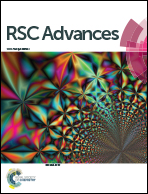Ni–Cu nano-crystalline alloys for efficient electrochemical hydrogen production in acid water
Abstract
In this work, Ni, Cu and Ni–Cu nano-crystalline alloys were electrochemically deposited on a Cu electrode (Cu/Ni–Cu) by the galvanostatic technique and ultrasound waves in view of their possible applications as electrocatalytic materials for the hydrogen evolution reaction (HER). The obtained materials were characterized morphologically and chemically by XRD and scanning electron microscopy, SEM, coupled with EDX analysis. The HER activity of the prepared electrodes was studied in acidic media (0.5 M H2SO4 solution) by the polarization measurements and EIS technique. It was shown that the electrodeposited Ni–Cu alloy coatings possess high catalytic activity for hydrogen evolution in the acidic solutions. The electrocatalytic activity of the prepared electrodes depended on the morphology and the microstructure. Ni–Cu surfaces exhibited an enhanced catalysis for HER with respect to the Ni and Cu cathode, which is mainly attributed to the high surface area of the developed electrode. Ni–Cu deposits with a Cu content of 49 at% manifests the highest intrinsic activity for HER as a consequence of the synergetic combination of Ni and Cu. The experimental impedance data were fitted to theoretical data according to a proposed model for the electrode/electrolyte interface.


 Please wait while we load your content...
Please wait while we load your content...